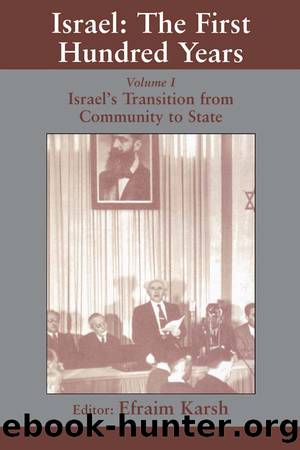Israel: the First Hundred Years by Karsh Efraim

Author:Karsh, Efraim
Language: eng
Format: epub
ISBN: 9781135298135
Publisher: Taylor and Francis
CONCLUSION
A change in the attitude of the Zionist establishment towards land purchases and settlement activity within the Jerusalem vicinity occurred in the wake of the Arab uprising in 1936 and the increased British and international attempt to find a solution to the Palestine Problem. Until that time the environs of Jerusalem enjoyed a very low priority in Zionist plans regarding land purchase and settlement. Primary priority was accorded to the valleys and plains of Palestine. The expectation from 1937 onwards that political decisions on Jerusalem were imminent, dictated Zionist policy and actions in land purchases and settlement around Jerusalem at the close of the British Mandate in Palestine. From the Zionist standpoint, the environs of Jerusalem as a target of Zionist land purchases and settlement activities after 1937 resembled other physical and political frontier areas in Palestine such as the Upper Galilee, the Beisan Valley and the Negev. Indeed the Zionists were also apprehensive about the future of these areas fearing their exclusion from the boundaries of any future Jewish State. The objective of preventing this motivated massive land purchases and settlement activities in order to produce a situation where these areas, would at the appointed date, be included within the Jewish state.
If we examine the fate of Jerusalem's environs in the context of Zionist activities and land purchases from 1936, it is impossible to evade the question of whether they enjoyed priority even in this context? Did the scope of activity in the environs of Jerusalem from 1936 fulfil the declarations which have been quoted so liberally above? An examination of land purchases and settlement activity in the Upper Galilee, Beisan Valley, the South and the Negev (areas whose agricultural suitability was limited, ownership conditions were problematic and were also categorized by the Land Laws as zones where Jewish purchases were prohibited) in 1936â47 discloses the following facts. Firstly, in the Eastern Upper Galilee alone, the JNF purchased 81,400 dunams and established 18 new settlements. Additionally, in the high mountain area in the Eastern Upper Galilee, six settlements were established during the period surveyed.77 In the Beisan Valley 23,000 dunams were purchased and 12 new settlements were established.78 In the Negev, 93,000 dunams were purchased and 15 new settlements were established.79
One must additionally note that the Zionist âobligation to surround Jerusalem with a security belt of Hebrew national soil' was never realized by the end of the mandatory period.80 The environs of Jerusalem were not accorded any special priority. This reality emerges even if one was to contend that by the very definition of the Jerusalem environs we are dealing a priori with a region limited in scope, whose supply of available land for sale was limited from the outset and with a set of objective difficulties blocking purchases. Similar restrictions and others also existed in other areas which enjoyed national priority in the period of decision at the close of the mandate.
The environs of Jerusalem therefore enjoyed greater priority at the close of the mandate than they did during the first part of the mandatory era.
Download
This site does not store any files on its server. We only index and link to content provided by other sites. Please contact the content providers to delete copyright contents if any and email us, we'll remove relevant links or contents immediately.
| Africa | Americas |
| Arctic & Antarctica | Asia |
| Australia & Oceania | Europe |
| Middle East | Russia |
| United States | World |
| Ancient Civilizations | Military |
| Historical Study & Educational Resources |
The Battle of Mogadishu by Matt Eversmann & Dan Schilling(625)
The Confidence Men by Margalit Fox(542)
The Spymaster of Baghdad by Margaret Coker(539)
A History of the Muslim World since 1260: The Making of a Global Community by Vernon O. Egger(520)
Jack the Ripper and the East End by Peter Ackroyd(479)
Empire of Fear: Inside the Islamic State by Andrew Hosken(468)
Islam At The Gates: How Christendom Defeated the Ottoman Turks by Diane Moczar(465)
The Crimean War by Winfried Baumgart(465)
The Afghanistan File by Prince Turki AlFaisal Al Saud(462)
The Jerusalem Diamond by Noah Gordon(459)
Akhenaten by Dominic Montserrat(448)
A Concise History of Greece (Cambridge Concise Histories) by Richard Clogg(444)
Israel: Ancient Kingdom or Late Invention? by Daniel I. Block(443)
Enemy in the East by Rolf-Dieter Müller(439)
The History of Jihad by Robert Spencer(437)
The Privatization of Israeli Security by Shir Hever(430)
Destroying a Nation: The Civil War in Syria by Nikolaos van Dam(428)
The Nine Lives of Pakistan by Declan WALSH(420)
The Dirty War in Kashmir by Shujaat Bukhari(407)
